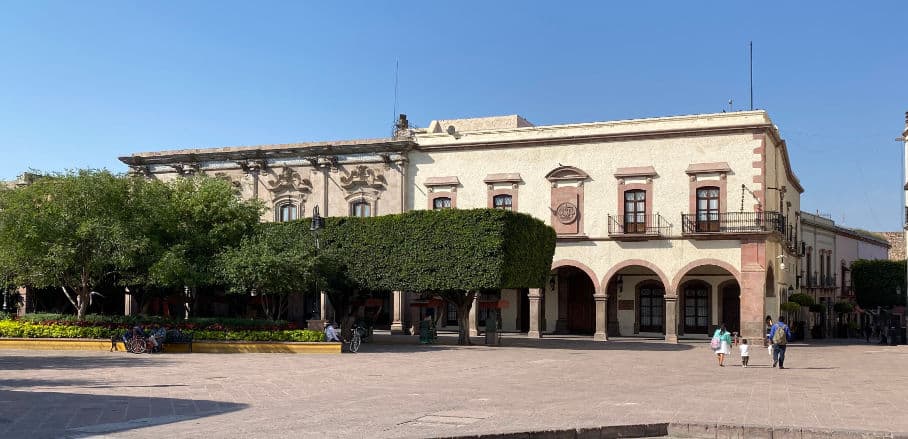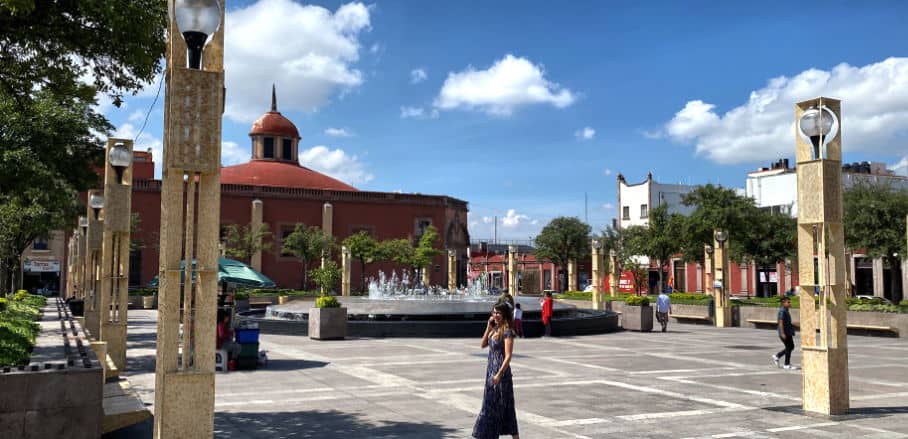The Right to Livability: Tackling Suburban Spaces and Peripheral Settlements
Embark on a journey through Queretaro’s urban transformation with Jorge Javier, where migration and climate challenges inspire pivotal changes. Uncover the compelling reasons driving transformative urban shifts for a sustainable and climate-resilient cityscape.
Cities have been growing steadily since the world wars by a confluence of factors including political transformations, a steady influx of rural-to-urban migration, and socio-economic shifts that have drawn people to suburban areas.

Guerrero plaza © Jorge Javier
However, the phenomenon of urban sprawl is almost out of control, especially in the global South. This expansion has resulted in the emergence of remote developments with uneven, unregulated density leading to a very complex relationship between housing, zoning, and local regulations. The mere creation of living space has proven to be insufficient —people need infrastructure and services to grow the community and create a proper gateway for jobs.
This problem has been a perennial one in Mexico. We have allowed thousands of new suburban centres, lacking vital infrastructure such as schools, places of culture, commercial premises, or office buildings. These developments sprawl around most of our larger cities stretching to great distances as far as a two-hour drive, resulting in significant neglect and serious gaps in the provision of housing.
The Challenge of Balancing Urban Development
Each year, we witness the social cost of treating real estate solely as a managed asset, focusing only on financialisation. This approach is driving up property prices and gentrifying older areas to attract new buyers, yet it does not translate into an influx of new residents.
According to UN guidance, we must seek the right balance between several key elements: open space, social growth, economic development, and human rights. Government involvement becomes pivotal in reshaping the urban framework as a mixed-use environment for our citizens. This approach encompasses a set of local strategies to create prosperity and social wellness for everyone, at least in theory.
Balancing Heritage and Mobility: A Fresh Take on Urban Planning
Sustaining our housing models demands a realistic appraisal of our old urban framework; the aspiration of a “15-minute city” within the confines of our current paradigm is simply not viable. First of all, we must ensure adequate services in all our communities, including clean water, sewerage, and energy. Then we must implement programmes for resilient cities. These initiatives should actively engage with society, with schools, job centres, and commercial areas that combine to create vibrant urban centres. We must start promoting and implementing a new polycentric vision.
Urban planning must honour historical events, values, and cultural heritage while simultaneously addressing issues of mobility and striving to transform the urban fabric into environments that prioritise the well-being of pedestrians, cyclists, and public transport.

Plaza de armas © Jorge Javier
With this in mind, we have been experimenting with innovative approaches in several cities in Mexico, progressively reclaiming public space one step at a time to create a more people-centred urban landscape.
Urban Revival in Queretaro: From Neglected Areas to Vibrant Communities
In the wake of the Covid-19 pandemic, we have understood the value of various spaces dedicated to remote working, and the role of parks and recreational areas to diversify our daily activities. Building on this newfound awareness, we have implemented some of these strategies in suburban areas in Queretaro for a more sustainable approach.

Pedestrian alley © Jorge Javier
For instance, in Corregidora, in the historic neighbourhoods that run parallel to the main roads we have undertaken a comprehensive transformation. Now, there are repurposed commercial buildings, new bicycle lanes, improved pedestrian paths, and better street lighting for a livable, walkable and safer environment.
One of the borough’s most iconic landmarks, the archaeological site of the Pyramid of El Pueblito, has been integrated into the urban context. This transformation has involved the building of cycle lanes, pavements and linear public spaces that allow for safer traffic in an area that was very neglected.
Even though we are struggling to avoid gated communities, certain areas have been opened up to recover the essence of an old-fashioned historical centre. These endeavours involve the expansion of sidewalks, pacifying traffic, and the removal of fences in plazas. The goal is to make vibrant, pedestrian-oriented zones and to restore a feeling of both security and livability.
In particular, the transformation extends to some of the alleys around the old municipal hall. These spaces have been redeveloped to avoid vehicular transit and encourage local restaurants to take over the streets, and to have full-fledged pedestrian pathways, allowing citizens to have spontaneous markets and ephemeral commercial premises.

Pueblito pedestrian © Jorge Javier
To complement these strategies, the introduction of new vehicular overpasses connecting secondary roads, and redefining road layouts have become instrumental. These improvements facilitate the creation of wider, better-lit pedestrian crossings, disrupting the local streets a little bit, but improving mobility between areas.
Heading west to La Cañada, at the sprout of the Queretaro River, historic industrial buildings have been morphing into restaurants, hotels, apartment blocks, and offices. This Transformation has been complemented by urban planning measures including, the widening of sidewalks, shifting road directions, and cleaning public spaces, thus, giving residents and visitors a better sense of local identity.

Queretaro river intervention © Jorge Javier
This urban remodelling has created adequate connectivity with the historic centre, extending to the Parish of San Pedro and San Pablo and the main square. Here, every year the traditional Fiesta de El Gallo is celebrated to preserve the customs and traditions of the nine neighbourhoods in honour of the Virgen de la Concepción de Hércules on December 8th, and the patron saint festivities in June, animating the festivities with Concheros and alebrijes, closing the streets and involving the whole town.
In the northern part of the city, the old farmers’ quarter, Santa Rosa Jauregui, now integrated into the urban sprawl of the metropolitan area, has adopted similar strategies. However, here the focus revolves around an amusement park and a very strong axis where the traditional carnitas kitchens still survive, again creating a vibrant place for people to enjoy.
Santa Rosa Jauregui has a longstanding tradition of celebrating the Patronal Feast of the Virgin of Santa Rosa de Lima and the Independence Day festivities. These events pay homage to the past, commemorating the route taken to warn the conspirators, lighting and exchanging torches, using the main street, and decorating along the main plaza with papel picado and flowers to remember hope and peace.
Beyond City Centers: Extending New Urban Techniques
Local actions like these can really enhance our urban life, but there is still a lot of work to do.
The city has been facing challenges in public transport with only the bus rapid transit system available. We need new policies to push new transportation systems, such as trams or an elevated metro.

Pueblito river intervention © Jorge Javier
Our city’s diverse topography, featuring natural barriers like beautiful glens, complicates transportation planning. However, the main problem is the large and heavily fragmented urban sprawl. The lack of connectivity between boroughs presents challenges to alternative means of transport and perpetuates dependence on automobiles.
We are looking for opportunities to apply our new urban techniques beyond the historical centres. The goal is to establish connections and mingle areas that have too long been separated, perhaps through the creation of open parks, blurring the divisions typically enforced by broad avenues.
In the future we must also face the challenge of including office districts, bringing them into a mixed-use world to improve livability. The shift aims to make workers’ schedules more flexible and improve the quality of life for everyone in the city.
- The Right to Livability: Tackling Suburban Spaces and Peripheral Settlements - 14. November 2023
